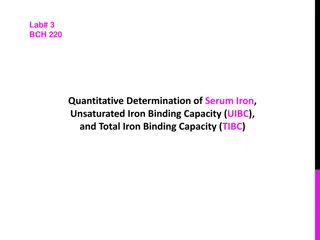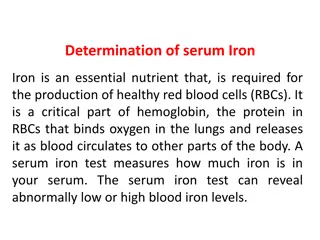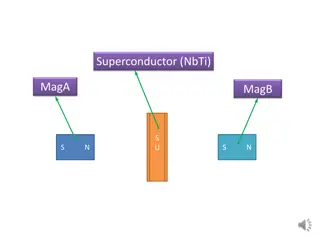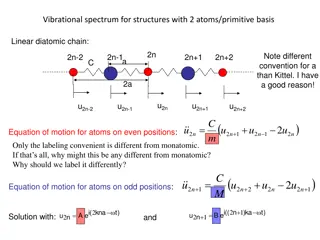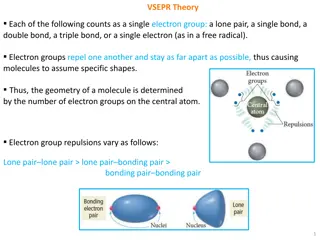Understanding Electron-Phonon Interactions in Iron-Based Superconductors
This discussion explores the effects of electron-phonon interactions on orbital fluctuations in iron-based superconductors. Topics covered include ab initio downfolding for electron-phonon coupled systems, evaluation methods such as Constrained Random Phase Approximation (cRPA), Constrained Density-Functional Perturbation Theory, and more. The interplay between electron and phonon dynamics, screening processes, and low-energy models are examined to provide insights into the complex behavior of these materials.
- Electron-Phonon Interactions
- Iron-Based Superconductors
- Ab Initio Downfolding
- Constrained Random Phase Approximation
- Density-Functional Perturbation Theory
Download Presentation

Please find below an Image/Link to download the presentation.
The content on the website is provided AS IS for your information and personal use only. It may not be sold, licensed, or shared on other websites without obtaining consent from the author. Download presentation by click this link. If you encounter any issues during the download, it is possible that the publisher has removed the file from their server.
E N D
Presentation Transcript
Effect of electron-phonon interactions on orbital fluctuations in iron-based superconductors A A YN, K. Nakamura, and R. Arita, arXiv:1305.2995
Ab initio downfolding for electron-phonon coupled systems Low-energy models for electron-phonon coupled systems: i,j: orbital (Wannier) indices (w): Wannier gauge : spin index O(p): the quantity with constraint (partially screened) Q. How do we evaluate ? A. Constrained random phase approximation (cRPA) F. Aryasetiawan et al., Phys. Rev. B. 70 19514 (2004)
Constrained RPA F. Aryasetiawan et al., Phys. Rev. B. 70 19514 (2004) Independent particle polarizability(RPA) V EF exclude the contribution from T T scattering T This screening process should be considered when we solve the low-energy effective model Occupied (O) V:virtual T:target
Ab initio downfolding for electron-phonon coupled systems Low-energy models for electron-phonon coupled systems: i,j: orbital (Wannier) indices (w): Wannier gauge : spin index O(p): the quantity with constraint (partially screened) Q. How do we evaluate and ? A. Constrained density-functional perturbation theory YN, K. Nakamura, and R. Arita, arXiv:1305.2995 cf. Desity-functional perturbation theory (without constraint) S. Baroni et al, Rev. Mod. Phys. 73, 515 (2001).
S. Baroni et al, Rev. Mod. Phys. 73, 515 (2001). Phonon frequency and electron-phonon coupling Phonon frequencies and electron-phonon couplings are given by (for simplicity we consider the case where there is one atom with mass M in the unit cell) phonon mode u : displacement of the ion Dynamical matrix : characteristic length scale where E : electron ground-state energy : cartesian coordinates (x,y,z) Key quantity bare Hartree + exchange correlation terms (screening)
Constrained density-functional perturbation theory YN, K. Nakamura, and R. Arita, arXiv:1305.2995 In the metallic case, is given by n,m: band indices V E F T exclude the target-target processes Occupied (O) Partially screened quantities such as and V:virtual T:target
Iron-based superconductors 1111 system 122 system G. R. Stewart, RMP 83, 1589 (2011). I. R. Shein and A. L. Ivanovskii, Solid State Commun. 149,1860 (2009). Y. Kamiahara et al., J. Am Chem. Soc. 130, 3296 (2008). 111 system 11 system and more G. R. Stewart, RMP 83, 1589 (2011). F.-C. Hsu et al., Proc. Natl. Acad. Sci. U.S.A. 105, 14262 (2008). G. R. Stewart, RMP 83, 1589 (2011). Z. Deng et al., Europhys. Lett. 87, 37004 (2009).
H. Kontani and S. Onari, PRL 104, 157001 (2010). T. Saito et al., PRB 82, 144510 (2010). Pairing symmetry: Iron pnictide Linearized Eliashberg equation: Band structure Fermi surfaces Here spin and charge fluctuations are given by and (within RPA) Without el-ph interactions With el-ph interactions such that s> c(spin fluctuations are dominant) W < 0 (repulsive) sign change in gap functions (s -state) c> s(charge fluctuations are dominant) W > 0 (attractive) no sign change (s++-state)
Role of electron-phonon interactions Spin fluctuations (enhanced by Hubbard U ) s -wave Orbital fluctuations (enhanced by el-ph interactions?) s++-wave Q. Do el-ph interactions really enhance the orbital fluctuations?
Phonon-mediated interactions Effective on-site el-el interactions coming from the exchange of phonons: momentum-space average -> on-site quantity We get cf. (Kontani & Onari) Jphis very small not negligible compared to Coulomb repulsion U ~ 2 eV these frequency dependent interactions vanish around l~ D
RPA analysis the magnitude of Jphis crucial to the enhancement of orbital fluctuations spin fluctuations are dominant (since Jphis small in magnitude) Gap functions in band representation T = 0.02 eV n(filling) = 6.1 5-orbitals model s -wave state is realized
Conclusion developed a method for ab initio downfolding for el-ph coupled systems Effective parameters for LaFeAsO: Uph(0) ~ U ph(0) ~ -0.4 eV, Jph(0) ~ -0.02 eV RPA analysis -> s (due to the smallness of Jph) YN, K. Nakamura, and R. Arita, arXiv:1305.2995












